|
March 1948 Popular Science
 [Table of Contents] [Table of Contents]
Wax nostalgic about and learn from the history of early
electronics. See articles from
Popular
Science, published 1872-2021. All copyrights hereby acknowledged.
|
Radiochemist? That's a new
term in my lexicon. Reading through this 1948 Popular Science magazine
"U.S. Alchemists Make Gold" article, I was thinking it could have been a chapter
out of one of the old Tom
Swift novels (of which I have read many), by Victor Appleton. In one of the
stories, Tom invented a new highly fissionable element he named "swiftonium," but
it was not located above uranium in the
Periodic Table, so obviously not possible since all the slots of naturally
occurring elements from 1 (helium) through 92 (uranium) were filled. An
element's atomic number is defined solely by the number of protons in its
nucleus, and there can be no fractional elements. If this had been an April
edition, then I might suspect it was a story for "fools." Swiftonium was just a
bit of science fiction Tom Foolery (see what i did there?). Alchemy is not
necessarily creating new elements but converting one element into another. Of
course we know that can be done via fission and fusion, or by allowing a
radioactive element to naturally decay, but alchemists sought to control the
process by simple means.
U.S. Alchemists Make Gold
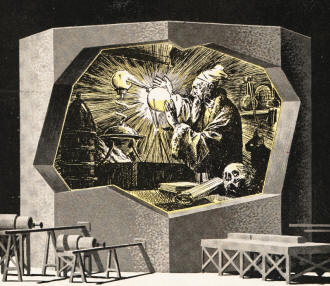
Dreams of the ancient alchemists come true in the chain-reacting
pile at Oak Ridge, Tenn.
By Alden, P. Armagnac
Drawings by Ray Pioch
Applying atomic magic to aid medicine and research, radiochemists duplicate nature's
elements and create new ones.
At Oak Ridge, Tenn., the United States Atomic Energy Commission has gone into
the business of manufacturing synthetic gold. The atomic pile is the Philosopher's
Stone, long sought by the ancient alchemists, which has the 24-carat touch.
Most curious part of the new enterprise is the odd behavior of the man-made gold.
Though locked in the strongest vault, most of it would disappear within a week's
time.
Strange to say, this extraordinary way of acting actually enhances the gold's
value. What makes it so desirable is the fact that it is radioactive. Hence the
ray-emitting "radio-gold" offers medical men a priceless tool for treating such
maladies as leukemia, lymphoma and Hodgkin's disease. At one institution alone,
Vanderbilt University Medical School in Nashville, Tenn., it has benefited 61 patients
in the first year of use.
For therapy and for "tagging" chemicals used in research, Oak Ridge's alchemists
- or "radiochemists," as they call themselves - produce scores of artificially radioactive
elements like radiogold. But they are by no means limited to "freak" products that
have no counterpart in nature.
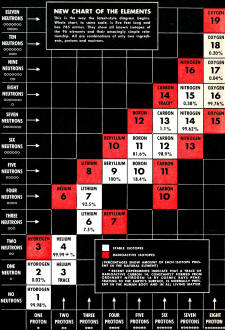
New Chart of the Elements
This is the way the latest-style diagram begins. Whole chart,
to same scale, is five feet long and has 785 entries. They show all known isotopes
of the 96 elements and their amazingly simple relationship. All are combinations
of only two ingredients, protons and neutrons.
Just as easily, they' can manufacture gold of normal behavior, perfectly acceptable
to the U. S. Treasury! It may not be the best way to get rich quick - the raw material,
as for radio gold, is platinum - but the fact that it has been done illustrates
their prowess in transmuting the elements. If future generals and geologists worry
no longer about strategic materials and dwindling natural resources because alchemists
can make any wanted element from others, it will be hardly more fantastic than what
has already been accomplished.
Behind the scientists' amazing feats with cyclotrons and atomic piles lies a
new understanding of the make-up of matter.

The Old and the New in "Elements"
1. In ancient times, alchemists believed that a drop of water
represented the simplest imaginable kind of a substance. Water, they thought, was
one of the fundamental and indivisible "elements" of which everything in the world
was made.
2. Then chemists discovered that water was a combination of
simpler "elements." Taking it apart, they found it to be made up of two dissimilar
substances, hydrogen and oxygen, in the proportions indicated by the familiar formula,
H2O.
3. Now 20th Century alchemists find that water actually consists,
not merely of two ingredients, but of five! Its "elements," hydrogen and oxygen,
turn out to have different varieties or isotopes, shown here with their identifying
numbers.
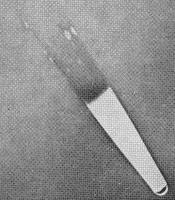
Newly discovered curium, most dangerous to handle
of all elements. is so violently radioactive that it bubbles and glows in this hollow
glass needle. Photo was made by element's own light.
Chemists once believed that ninety-odd substances such as hydrogen and oxygen,
called elements, were the ingredients of every material you could name - air, water,
flesh, blood. All the atoms of each element, they thought, were just alike.
Varieties of Elements Discovered
Now the list of the world's ingredients has been multiplied many times by the
discovery that these elements have important varieties, called isotopes. More than
700 different isotopes are known today. Those of the same element give the same
chemical reactions in a test tube, but they differ in weight and in more spectacular
ways. You can safely handle any amount of uranium 238, one of the isotopes of uranium.
Merely bring together something less than 220 pounds of another, uranium 235, and
its spontaneous explosion will level a city. Some isotopes are stable. Others, even
of normally well-behaved elements like iron and sulphur, may turn into something
else while your back is turned!
Resembling a gigantic crossword puzzle, a remarkable "isotope chart" recently
compiled by Prof. Emilio Segre, of the University of California, graphically illustrates
the new idea of what things are made of. Rows and columns of squares form a pattern
ascending diagonally from left to right. Horizontally, the chart ranges in order
the 96 elements now known. Vertically, it shows all known isotopes of each element.
Some squares even have double entries for "twin" isotopes having the same weight
but different radioactive life. Counting these, the 720 filled-in squares have 785
entries in all.
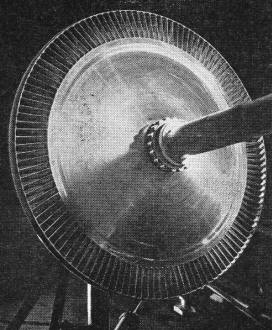
Elements long considered laboratory curiosities
sometimes meet vital needs. Columbium metal is an example. Used in heat-resisting
alloy for blades of turbine wheel.
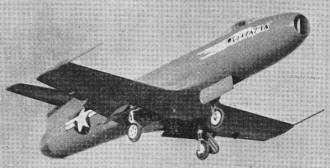
It has made possible the jet engines that drive world's fastest
planes like Navy's Skystreak, right.
It looks pretty complicated, until you notice the beautifully simple relationship
that the new chart reveals. Just two kinds of particles, it shows, make up everyone
of the 785 varieties and subvarieties of elements. One is the proton, the positively
charged core of the hydrogen atom, discovered in 1886. The other is the neutron,
an electrically neutral particle, discovered in 1932. These two particles are the
true building blocks of the universe.
Join the right number of protons and neutrons to make the core or nucleus of
an atom - a neat trick if you can do it - and you will have any isotope of any element
you want. The number of protons determines what the element will be. One proton
makes hydrogen, two make helium, and so on up to 96 for newly discovered curium.
The total number of particles, protons plus neutrons, determines what isotope you
will get. This is the number, therefore, that you write after the name of an element
to identify a particular isotope. It's all as simple as that.
To apply this idea and perform a bit of alchemy, you need only walk near an operating
cyclotron with a little loose change in your pocket. For a while afterward, all
your dimes and quarters will be radioactive enough to make a Geiger counter click.
Subsequently, they'll contain a trace of cadmium metal that the U. S. Mint never
put there.
What has happened? An atom of silver in the coin - say silver 107, which has
47 protons and 60 neutrons - picks up another neutron from the cyclotron. The result
is silver 108, the isotope that contains one more neutron than silver 107. It is
radioactive and emits a negative electron, or beta ray. As it does so, one of its
neutrons turns into a proton. It therefore becomes cadmium, the element that has
one more proton than silver; and the isotope is cadmium 108, which is stable.
Wizards of Oak Ridge similarly produce "radioisotopes" (radioactive isotopes)
of elements ranging from antimony to zirconium. Given time, they could change the
world around pretty radically, since all their radioisotopes eventually turn into
stable elements-and these are usually quite different from the elements they started
with.
Naturally radioactive elements can also be duplicated. Polonium 210, the natural
form that turns into lead, has been produced from bismuth in a high-voltage atom
gun at the University of Michigan.
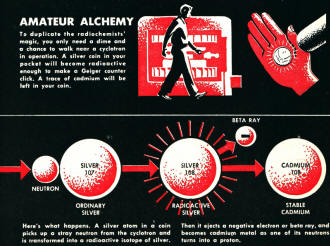
Amateur Alchemy
To duplicate the radiochemists' magic, you only need a dime and a chance to walk
near a cyclotron in operation. A silver coin in your pocket will become radioactive
enough to make a Geiger counter click. A trace of cadmium will be left in your coin.
Here's what happens. A silver atom in a coin picks up a stray neutron from the
cyclotron and is transformed into a radioactive isotope of silver.
Then it ejects a negative electron or beta ray, and becomes cadmium metal as
one of its neutrons turns into a proton.
Awe-inspiring to earlier chemists was their powerlessness to start, stop, or
control in any way the radioactive process that in nature's own good time gives
birth to the various members of the radium, actinium, and thorium families. It could
neither be hastened nor retarded by the most potent forces they could bring to bear
- the searing heat of the blast flame, the frigid cold of liquid air, or the crackling
discharge of millions of volts of electricity. But now the great 184-inch cyclotron
of the University of California has shown how to give nature a boost. It turns uranium
directly into a remote member of the actinium family, Actinium X - a process for
which nature requires five successive steps and, on the average, more than 700,000,000
years!
In 1939, a cyclotron yielded a radioactive metal new to science - technitium,
the first element to be discovered by its artificial creation. All newer elements,
except francium, have come from the cyclotron and atomic pile - astatine, neptunium,
plutonium, curium, americium, and prometheum. Plutonium, of atom-bomb fame, was
also the first synthetic element made by the pound.
Prometheum and technitium, the two synthetic elements believed most surely absent
in nature, now are available from Oak Ridge. Substantial quantities could be produced
as by-products of future atomic-power piles, if experimenters find they have important
practical uses.
These men may well bear in mind the success story of the "Cinderella" element,
columbium. As late as 1928, making a disk the size of a half dollar would nearly
have exhausted the world's supply of this steel-gray metal. In 1929, a Chicago chemist
proudly exhibited the first rods and plates of columbium - and frankly admitted
he couldn't imagine any use for them. Today, as a result of wartime research, columbium
has become indispensable. It forms a small but essential fraction of a heat-resisting
alloy for the turbines of the world's fastest jet planes. Anyone of the newest elements
made by alchemists may likewise prove a necessity in the world of tomorrow.
Posted January 10, 2024
|
















